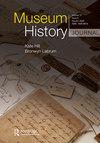Curatorial practices and ‘intrinsically English’ art: The British pavilion at the Venice Biennale
IF 0.2
Q3 HISTORY
引用次数: 0
Abstract
ABSTRACT British artists have been a constant presence at the Venice Biennale from the very beginning in 1895, installed in the only existing pavilion alongside others international artists. In 1909, a dedicated British Pavilion was built in the Saint Elena Gardens. This paper charts the development of the British curatorial choices that have taken place at the Biennale since its outset. Rather than being a chronological history, it deals with aspects of power concerning the relationship between the authority of the British Pavilion's curatorial practices and those of the Biennale's curators and institution. The text highlights the peculiar political and managerial situation of the Venice Biennale, one that creates three levels of power confrontations. The first is between the structures of the Italian institution and those of the British Pavilion; the second is between the British government and the curators of its pavilion; and the third is between the curatorial choices taking place as part of the British Pavilion and those of other pavilions. This case study, which makes use of unpublished documents, highlights the singularities and commonalities of British curatorial practices at the Venice Biennale and offers the opportunity to reveal dialogues and tensions.策展实践与“本质上的英国”艺术:威尼斯双年展英国馆
摘要从1895年开始,英国艺术家就一直在威尼斯双年展上亮相,与其他国际艺术家一起被安置在现存唯一的展馆中。1909年,圣埃琳娜花园建造了一座专门的英国馆。本文描绘了自双年展开始以来英国策展选择的发展。它不是一部按时间顺序排列的历史,而是涉及权力的各个方面,涉及英国馆策展实践的权威与双年展策展人和机构的权威之间的关系。该文本强调了威尼斯双年展独特的政治和管理状况,其中产生了三个层面的权力对抗。第一个是在意大利机构和英国馆的结构之间;二是英国政府和展馆馆长之间的纠纷;第三个是作为英国馆的一部分和其他展馆的策展选择之间的选择。这项案例研究利用了未发表的文件,突出了英国在威尼斯双年展策展实践的独特性和共性,并为揭示对话和紧张关系提供了机会。
本文章由计算机程序翻译,如有差异,请以英文原文为准。
求助全文
约1分钟内获得全文
求助全文

 求助内容:
求助内容: 应助结果提醒方式:
应助结果提醒方式:


